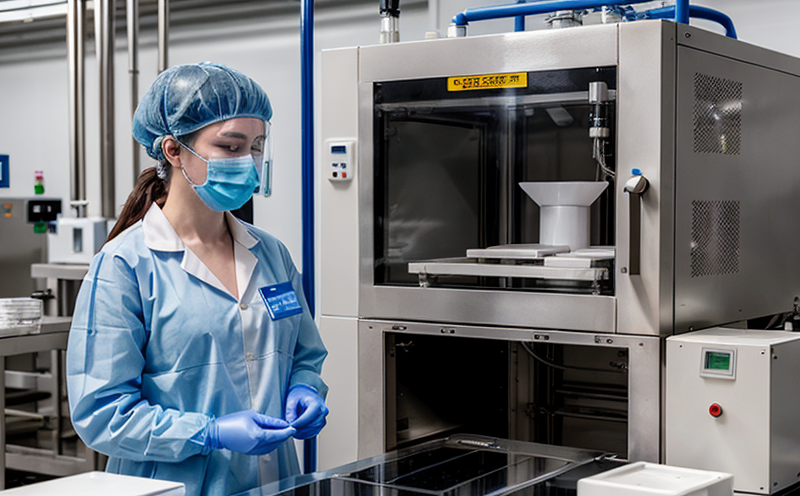GMP Sterility Assurance Testing
Good Manufacturing Practice (GMP) compliance is a critical aspect of pharmaceutical manufacturing. Ensuring that products meet the highest standards of quality, safety, and efficacy is paramount in protecting public health. GMP Sterility Assurance Testing plays an essential role in this process by ensuring that sterile materials are free from contamination. This testing ensures that any product labeled as sterile adheres to stringent regulatory requirements such as those outlined by the FDA, EMA, and WHO.
The primary goal of sterility assurance tests is to detect any microbial contaminants that could compromise the safety and effectiveness of a product. These tests involve rigorous methodologies designed to simulate real-world conditions under which the product might be used. The test requires highly controlled environments and specialized equipment to ensure accurate results. Properly conducted, these tests can help prevent contamination during manufacturing processes, thereby reducing the risk of recalls or product withdrawals.
During this testing process, various methods may be employed depending on the nature of the material being tested. Common techniques include membrane filtration, direct plating, and use of growth media. Each method has its own set of protocols designed to capture potential contaminants effectively while minimizing false positives or negatives. It is crucial that all personnel involved in conducting these tests are trained professionals who understand both theoretical principles and practical applications.
The importance of GMP Sterility Assurance Testing cannot be overstated, especially when considering the sensitive nature of pharmaceutical products. By adhering strictly to established procedures and standards, laboratories can maintain consistent quality across batches of medication or medical devices. This not only enhances patient safety but also fosters trust between manufacturers and regulatory bodies.
For effective GMP Sterility Assurance Testing, it is essential that laboratories possess state-of-the-art facilities capable of supporting multiple types of tests simultaneously. Advanced instrumentation such as automated microbial detection systems can significantly enhance accuracy while reducing turnaround times. Regular calibration checks ensure continued reliability over time. Furthermore, maintaining strict adherence to Good Laboratory Practices (GLPs) helps guarantee consistent results regardless of external factors like environmental changes or personnel turnover.
Regulatory authorities worldwide emphasize the critical role played by GMP Sterility Assurance Testing in safeguarding public health. Compliance with relevant guidelines ensures that pharmaceutical companies adhere to best practices throughout their operations, from raw material sourcing through final product release. Failure to comply can lead to severe consequences including fines, product recalls, and potential legal action.
In conclusion, GMP Sterility Assurance Testing is vital for ensuring the safety and efficacy of medical products destined for human consumption or use. By leveraging advanced technologies and adhering strictly to established protocols, laboratories can provide reliable evidence demonstrating compliance with stringent regulatory requirements.
Applied Standards
| Standard Name | Description |
|---|---|
| ASTM E1057 | Procedure for Testing Sterility of Medical Devices and Products Using Membrane Filtration Technique. |
| ISO 11737-1 | Guideline on the Use of Direct Plating Methods for Detecting Microbial Contaminants in Liquid Samples. |
| EU MDD Annex I, Paragraphs 5.8 and 6.2 | Requirements related to sterility testing in medical devices. |
| WHO Guidelines | International recommendations for ensuring product safety during manufacturing processes. |
Customer Impact and Satisfaction
- Enhanced confidence in the quality of pharmaceutical products.
- Promotes trust between manufacturers, suppliers, and regulatory agencies.
- Avoids costly recalls due to contamination issues.
- Reduces risks associated with using potentially harmful substances.
By ensuring that all batches meet strict sterility requirements, GMP Sterility Assurance Testing contributes significantly towards maintaining high standards of product quality. This ultimately leads to greater customer satisfaction and loyalty among those who rely on these medications or devices for their health needs.
Use Cases and Application Examples
- Pipeline Products: Early-stage testing helps identify potential issues early in the development process, allowing for necessary adjustments before large-scale production.
- Final Product Release: Ensures that finished goods are free from any microbial contaminants prior to distribution or sale.
- Batch Verification: Routine verification checks help maintain consistent quality throughout manufacturing runs.
- Supply Chain Oversight: Monitoring suppliers helps ensure they meet the same stringent criteria as the manufacturer.
In summary, GMP Sterility Assurance Testing is integral to various stages of pharmaceutical production and supply chain management. It serves multiple purposes ranging from early-stage research through final product approval.





